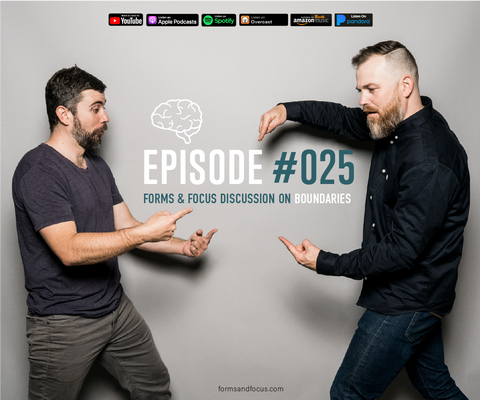
#25 Forms & Focus Discussion on Boundaries
PUSH OUT THE PUSHOVER
Everyone teaches you to be a pushover, now it’s time to learn how to stand up for your dreams.
The brain is wired to understand the physical boundaries around you to keep you from falling off a cliff, but society has taught you to sacrifice your personal boundaries at the expense of everyone else. And while doing so, you have little time for your dreams.
On today's episode of the Forms and Focus Podcast (EPISODE #025), we are discussing focus and boundaries. And what you can do TODAY to establish healthy boundaries, increase your focus on long-term goals, and accomplish your dreams. Let’s dig in…
0:00 - Intro to Boundaries
0:34 - Podcast Intro
1:02 - Problem/Boundaries and how it impacts our focus
10:03 - Solution/Habits for better focus
LISTEN TO EPISODE
WATCH EPISODE
SHOW NOTES FOR EPISODE #25
The Brain Creates a Buffer
Meghan Rabbit in “What you need to know about personal Space.”
There are brain regions that are sizing up the space around you: the parietal cortex (which processes sensory information) and the premotor cortex (which plays a role in generating movements).
“These areas of the brain have neurons that fire to let you know if something or someone is getting too close, and you unconsciously respond, says Graziano. “I call them ‘bubble wrap’ neurons, and they align your vision, hearing, and sense of touch to build a multisensory map of space that helps you create a bubble wrap of safety around your body.”
So How Close Is Too Close?
Maghan continues… Research from the 1960s, which scientists agree still holds up, identified four of these, each reserved for different people in your life.
Intimate space: up to 18 inches from your body. Family
Personal space: between 1.5 & 4 feet from the body. Friends
Social space: Between 4 to 12 feet; new acquaintances and strangers
Public space: is beyond that
Why we Suck at Setting Personal Boundaries: Bethany Juby, “Personal Boundaries: Types and How to Set Them.”
From childhood, we’re often taught to bend and mold ourselves to make others comfortable. EXAMPLE: Messaging is implied (as in school dress codes). Direct (“I don't care if you don’t want to hug your grandfather, it’s rude not to!”).
She continues.. We’ve been taught from a young age to put the feelings of others ahead of our own needs, to the point that many of us don’t even know how to answer, “What are boundaries?” How do I set them?”
Annie Tanasugarn in “Personal Boundaries and Building Self Love.” Unhealthy or weak personal boundaries are often identified as having a poor sense of self-identity or limited feelings of self-worth. For many who grew up in a codependent environment, they may be out of touch with their own feelings, or may have not been allowed personal space earlier in life.
Categories & Environments Where Personal Boundaries Are Important
- Annie continues.. These boundaries typically fall into a few specific categories: emotional (protecting our own emotional well-being)
- physical (protecting our physical space)
- sexual (protecting our needs and safety sexually)
- workplace (protecting our ability to do our work without interference or drama)
- material (protecting our personal belongings)
- time (protecting the use, and misuse, of our time)
Anytime you are interacting with other humans, you have to set boundaries. But how?
How to set personal boundaries.
First and foremost, from the book Boundaries by Henry Cloud, “It is an act of kindness to yourself and those around you to set boundaries.”
Some tips from Ben Hershey, “8 Ways to Establish Healthy Boundaries at Work.” He references Doctor Dana Gionta’s book, From Stressed to Centered, which offers a step-by-step process for assessing personal boundaries at work:
Know your limits
Pay attention to your feelings
Give yourself permission to set boundaries
Consider your environment
Communicate Upfront: “I don’t answer emails past 7:00 PM
Create Clear Structures: Structure is important in the workplace. You're the architect of your own boundaries, so build them solid.
Keep Your Relationships Professional:
Delegate Work When Appropriate: One important part of establishing boundaries is in setting expectations about the work you will do. Book, Get the Monkey Off Your Back.
Actually Take Time Off: One Hour A Day, A week a quarter.
RESOURCES
- BOOK: Get That Monkey Off Your Back: Helpful hints guide to a happier and healthy lifestyle. By Debra Fleming
- BOOK: Boundaries: When to Say Yes, How to Say No to Take Control of Your Life by Henry Cloud
- Good boundaries free you | Sarri Gilman | TEDxSnoIsleLibraries
- Why People Pleasing is Hurting You | Salma Hindy | TEDxUofT
WORKS CITED
Contessa, Career, and Ben Hershey. “8 Ways to Establish Healthy Boundaries at Work.” Career Contessa, https://www.careercontessa.com/advice/healthy-boundaries-at-work/. Accessed 11 April 2022.
Juby, Bethany. “Personal Boundaries: Types and How to Set Them.” Psych Central, 7 June 2021, https://psychcentral.com/lib/what-are-personal-boundaries-how-do-i-get-some. Accessed 11 April 2022.
Rabbit, Meghan. “What You Need to Know About Personal Space - The Science of Personal Boundaries.” Prevention.com, 17 August 2019, https://www.prevention.com/health/a28692075/personal-space/. Accessed 11 April 2022.
Tanasugarn, Annie. “Personal Boundaries and Building Self Love.” Psych Central, 29 June 2020, https://psychcentral.com/blog/personal-boundaries-and-building-self-love#1. Accessed 11 April 2022.

Comments (0)
There are no comments for this article. Be the first one to leave a message!